Ankle sprains are quite common (taking up 20% of athletic related injuries). You may have even had an ankle sprain sometime yourself! As an athlete, or an active individual it is incredibly useful to know how the body work s, and what causes injuries (so that you know how you can help them heal). Today Chloé Sardin will take a look at the ankle, focusing on what causes sprains, the different types of sprains (or tears) that can occur, and some useful ways that osteopathy can help.
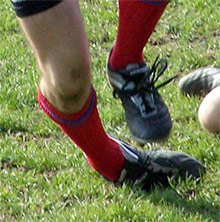 Did you know that 20% of sports-induced injuries are lateral ankle sprains? Most people will experience one at some point in their life and the degree of severity will vary.
Did you know that 20% of sports-induced injuries are lateral ankle sprains? Most people will experience one at some point in their life and the degree of severity will vary.
A sprain is a traumatic lesion affecting a joint, caused by a lengthening or tear of the ligament fibers holding the joint together. When we talk about an ankle sprain there are actually different joints that can be affected.
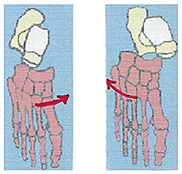 Depending on the direction of the trauma, the inside or outside of the ankle will be affected (the latter is more common), or some joints in the foot can also be affected (sometimes call “low ankle sprain”).
Depending on the direction of the trauma, the inside or outside of the ankle will be affected (the latter is more common), or some joints in the foot can also be affected (sometimes call “low ankle sprain”).
The degree of gravity of the sprain will depend on:
- If it is a stretch or a true tear of the ligament
- How many ligaments are affected
- If tendons (connective tissue endings of the muscles attaching onto bones) or bones are torn or broken
- If tendons and bones are torn or broken
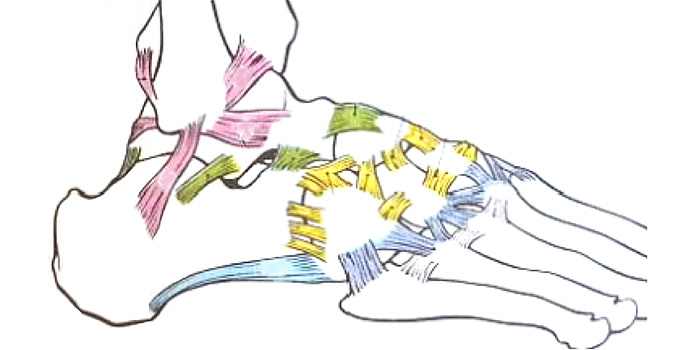
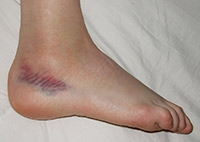 The ankle will usually swell, and can bruise very quickly (blood vessels inside the ligaments are bleeding a bit), and you will find it difficult to walk on it. If you go to the doctor, he/she will evaluate the need to do an x-ray based on specific criteria of age, weight bearing, and palpation. Then you will be prescribed an anti-inflammatory cream or drug and sometimes asked to wear a splint. Finally, physiotherapy may be recommended to strengthen the muscles of the lower leg and work on your balance.
The ankle will usually swell, and can bruise very quickly (blood vessels inside the ligaments are bleeding a bit), and you will find it difficult to walk on it. If you go to the doctor, he/she will evaluate the need to do an x-ray based on specific criteria of age, weight bearing, and palpation. Then you will be prescribed an anti-inflammatory cream or drug and sometimes asked to wear a splint. Finally, physiotherapy may be recommended to strengthen the muscles of the lower leg and work on your balance.
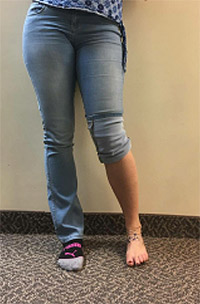 Now here’s how your Osteopath can help you: your feet are the foundation of your body, and the hypermobility of your ankle will create compensation higher up towards your knees, hips, pelvis, lower back, etc. Moreover, after a strain, you will tend to limp around for a while, which again shifts your body weight towards your other leg, leaving tensions in the muscles, connective tissues, and the joints in its wake.
Now here’s how your Osteopath can help you: your feet are the foundation of your body, and the hypermobility of your ankle will create compensation higher up towards your knees, hips, pelvis, lower back, etc. Moreover, after a strain, you will tend to limp around for a while, which again shifts your body weight towards your other leg, leaving tensions in the muscles, connective tissues, and the joints in its wake.
In a nutshell, the treatment will look at all those elements to try to figure out how your body tried to help you be pain free and functional by shifting different physical elements. An Osteopathic treatment will likely involve draining the lymphatics and increasing the blood flow to reduce the swelling. Lastly, we will check the rest of your body for postural changes.
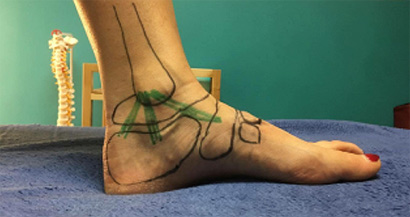 It’s important to be mindful of the looseness (laxity) of the ankle if you are going to play sports again or walk on uneven ground. Ask your health practitioner when it is a good time to resume activities and for any advice specific to healing the injury. Warming up before exercise is going to be more important than ever, and fatigue will make the likelihood of another sprain higher. In my experience, athletes have a tendency to go back to their activities earlier than they should, which often causes a re-injury of the joint and worsening of the symptoms.
It’s important to be mindful of the looseness (laxity) of the ankle if you are going to play sports again or walk on uneven ground. Ask your health practitioner when it is a good time to resume activities and for any advice specific to healing the injury. Warming up before exercise is going to be more important than ever, and fatigue will make the likelihood of another sprain higher. In my experience, athletes have a tendency to go back to their activities earlier than they should, which often causes a re-injury of the joint and worsening of the symptoms.
Want to know more about how ankle sprain can lead to other injuries? Read our article: “You Might Not Be A Klutz: It Could Be Your Ligaments!”
And, of course, if you’d like help recovering from a nasty ankle sprain, you can book an appointment with me here.
